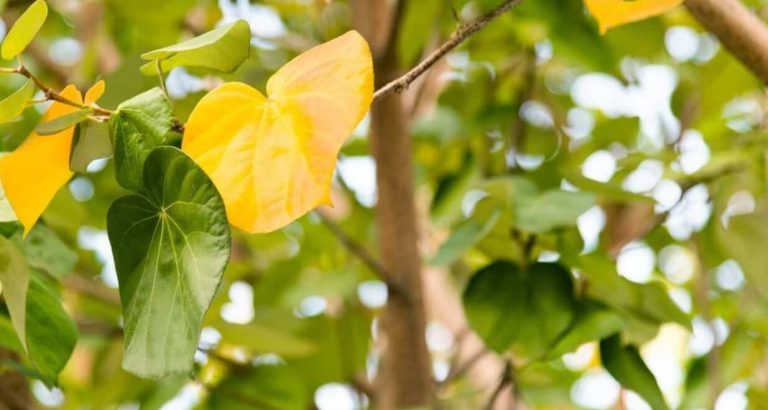Key Takeaways why is my hibiscus leaves turning yellow?
- Overwatering and underwatering are the most common culprits behind yellow hibiscus leaves. Adjust your watering schedule accordingly.
- Lack of sunlight can lead to yellowing. Place your hibiscus in a spot with at least 6 hours of direct sun.
- Cold temperatures and drafts can cause leaf discoloration. Protect your plant during winter.
- Nutrient deficiencies manifest as yellow leaves. Fertilize regularly with a balanced plant food.
- Improper soil pH affects nutrient absorption. Test and amend your soil pH if needed.
- Pests like aphids and mites suck sap and cause yellowing. Practice diligent pest control.
- Prune off affected yellow leaves to encourage new healthy growth.
- Address yellow leaves promptly to prevent ongoing damage.
| Issue | Solution |
|---|---|
| Overwatering or underwatering | Adjust watering frequency based on soil moisture. |
| Insufficient sunlight | Provide at least 6 hours of direct sun daily. |
| Cold temperatures | Protect from frost and provide warmth in winter. |
| Nutrient deficiency | Fertilize regularly during growing season. |
| Improper soil pH | Test and amend soil pH to around 6.5. |
| Pest infestation | Inspect closely and treat pests accordingly. |
| Damaged leaves | Prune off severely affected yellow leaves. |
| Ongoing issues | Address problems promptly to prevent decline. |
| Mysterious symptoms | Seek expert help if needed. |
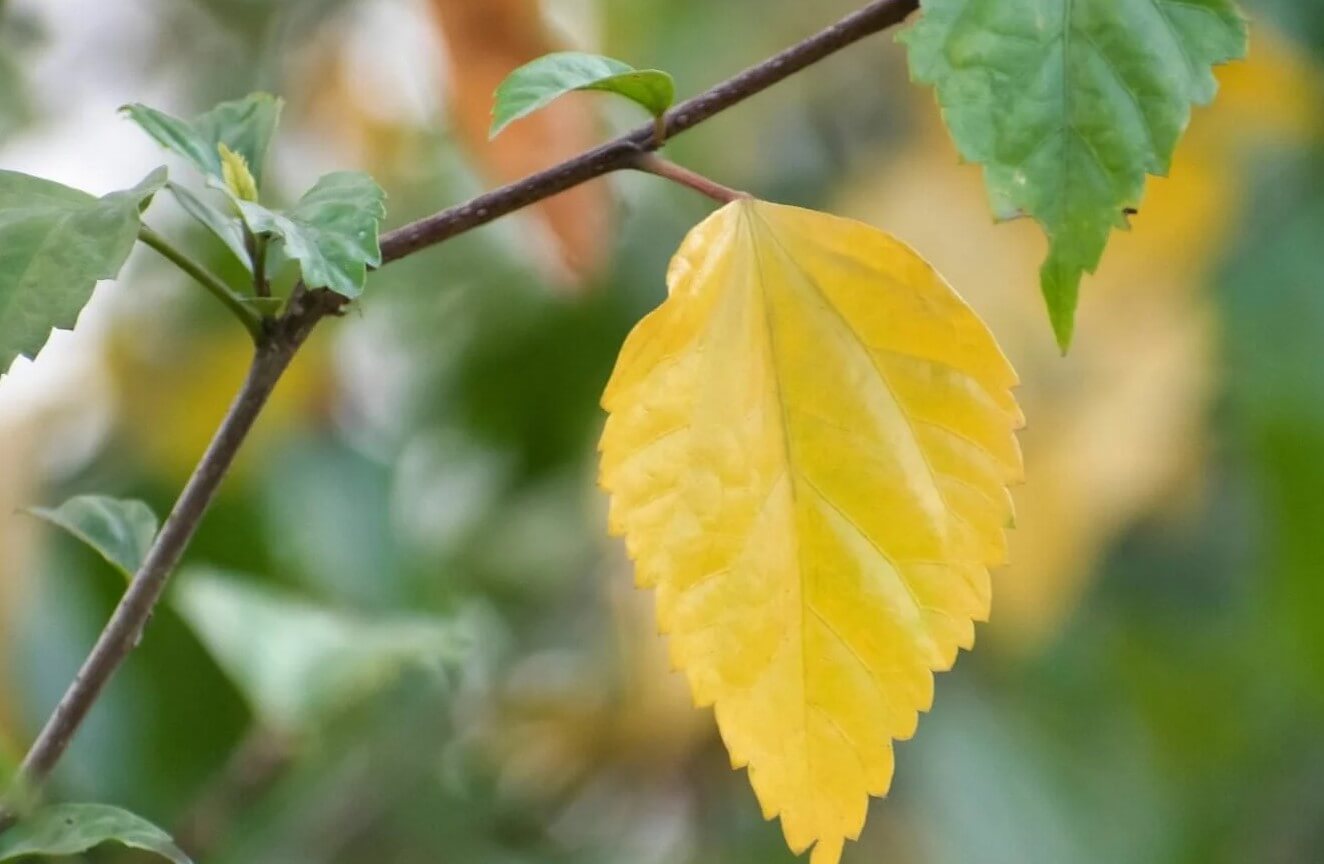
Overwatering and Underwatering
Yellowed hibiscus leaves surrounded by gardening tools in a bustling atmosphere.
The most common and easily adjustable cause of yellow hibiscus leaves is improper watering. Both overwatering and underwatering can lead to stressed roots and cause the leaves to turn yellow.
Hibiscus Leaves Turning Yellow: Overwatering
A common reason for hibiscus leaves turning yellow is overwatering. Your plant might be getting more hydration than it needs, leading to waterlogged roots and lackluster foliage. Too much water can inhibit oxygen flow to the roots, causing them to weaken or even rot.
The result? Yellowing leaves on your beloved hibiscus. To avoid this issue, allow the soil of your hibiscus plant to dry out slightly between each watering session. Not too parched, just pleasantly thirsty! More isn’t always better when it comes to watering – go easy with that watering can!
Hibiscus Leaves Turning Yellow: Underwatering
You’re probably aware that your hibiscus needs a good amount of water to stay healthy. But, did you know underwatering can lead to yellowing leaves too? Yes, it’s true. Underwatered hibiscus plants react with yellow leaves as they struggle to meet their hydration requirements.
Dehydration leads the plant into stress mode, causing them to turn yellow and drop off eventually. How do you identify this? Look for other telltale signs like wilting or curled up foliage along with yellow leaves on your hibiscus plant’s exterior layers – these symptoms often indicate insufficient water supply.
Be sure to keep the soil moist but not drenched; Just enough so it doesn’t dry out completely between watering sessions is key for maintaining optimal color in those lush hibiscus leaves.
Solutions for Watering Issues
- Carefully monitor soil moisture before watering – stick your finger in the soil to check dryness.
- Water thoroughly until it drains from the bottom, then don’t water again until the top few inches become dry.
- Space out watering to allow more time for soil to dry between sessions.
- Use pots with drainage holes and well-draining soil to prevent sogginess.
- Add pebbles or gravel at the base to improve drainage.
- Pour water directly into the soil slowly and gently to avoid wetting leaves.
- Consider using drip irrigation for more controlled watering.
- Add mulch on top of the soil to retain moisture better.
- Move plant to a shadier spot to slow moisture loss.
- Avoid watering at night to prevent fungal issues from leaves staying wet.
- Mist leaves instead of watering from above to increase humidity without overwatering.
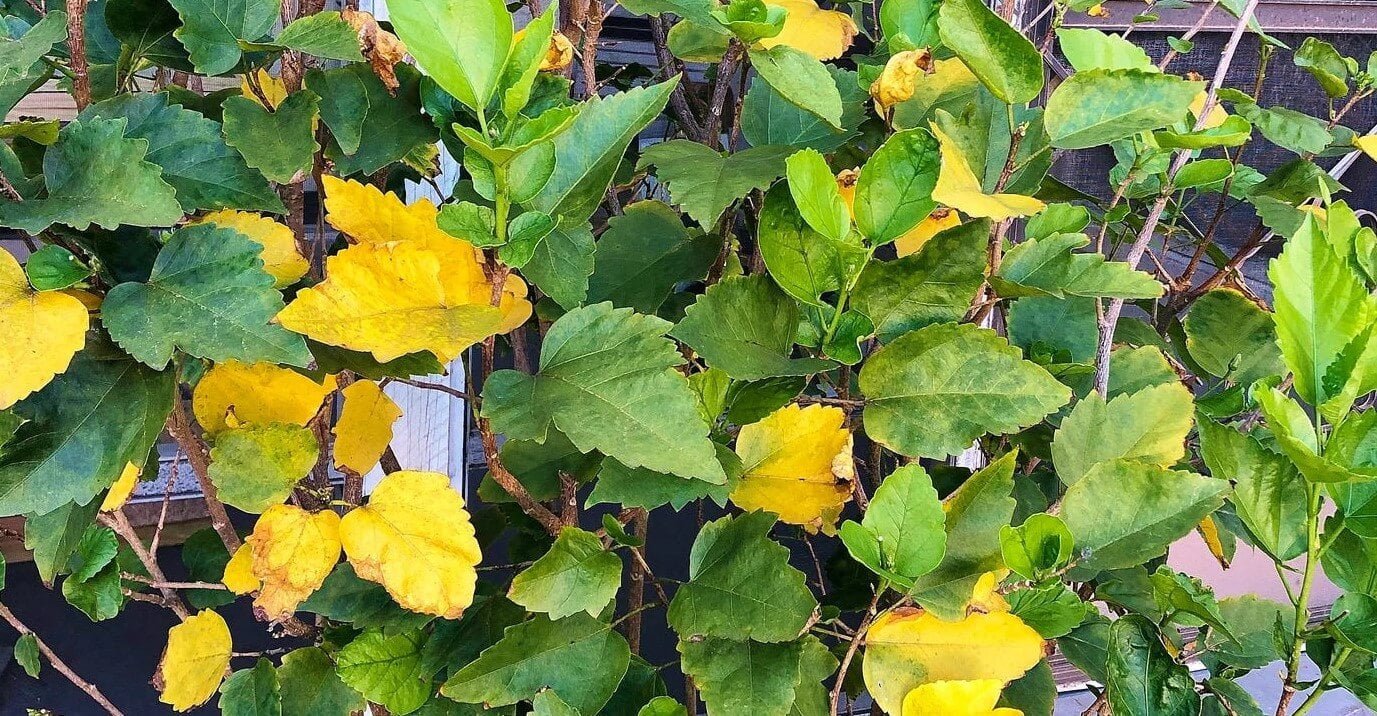
Hibiscus Leaves Turning Yellow: Light Deficiency
To keep your hibiscus healthy and vibrant, it needs an adequate amount of light. A lack of sunlight can cause the leaves to turn yellow. Hibiscus plants thrive in full sun conditions with at least 6-8 hours of direct sunlight each day.
If your hibiscus is not receiving enough light, consider moving it to a brighter location or providing additional artificial lighting if you’re growing it indoors. Remember that even though hibiscus loves sunlight, it’s important to protect them from intense afternoon sun, especially during hot summer months.
So find a balance between giving them adequate light and protecting them from scorching heat! Insufficient light will cause the leaves to appear pale, limp, and eventually yellow.
Solutions for Light Issues
- Place hibiscus in a south-facing window if growing indoors.
- Move outdoor hibiscus plants into full sun rather than partial shade.
- Rotate indoor plants regularly so all sides get sufficient light exposure.
- Supplement with grow lights if indoor natural light is inadequate.
- Provide shade from intense mid-day sun in summer using curtains or shade cloth.
- Prune back overgrown branches and leaves to improve interior light penetration.
- Use reflective surfaces like white walls or foil to bounce more light onto your plant.
- Avoid placement near trees or buildings that could block sunlight.
- Monitor for signs of phototropism where leaves excessively reach for light.
Hibiscus Leaves Turning Yellow: Cold Temperatures
Your hibiscus plant’s tropical origin means it has a natural proclivity for warmer climates. Exposure to cold temperatures is one of the most common causes hibiscus leaves turn yellow.
As winter winds howl and temperatures drop, your once-flourishing plant may bear the brunt, leading to leaf yellowing or even complete loss of foliage. The chill can damage cell membranes in hibiscus leaves, causing them to lose their vibrant green color and morph into a concerning shade of yellow.
Always ensure your tropical beauty stays warm; if you have a potted hibiscus indoors during winter months— that’s perfect! But for outdoor ones, consider relocating them inside or provide some kind of insulation cover during periods of extreme cold.
Protecting your hibiscus from cold temperature is critical not just for keeping its leaves green but also ensuring overall health and longevity.
Solutions for Cold Temperature Issues
- Move potted hibiscus plants indoors before frost sets in.
- Use cold frames, cloches, or row covers to protect outdoor plants.
- Place outdoor container plants together and wrap with insulation.
- Cover with frost cloth or burlap if cold snaps occur unexpectedly.
- Avoid drafty areas indoors near doors or AC vents.
- Maintain indoor temperatures above 60°F for hibiscus.
- Set up space heaters or heating mats to warm the area around your plant.
- Improve insulation around roots by mulching heavily.
- Delay pruning until after the last frost to maximize foliage protection.
- Provide warmth and humidity by misting leaves regularly.
Hibiscus Leaves Turning Yellow: Nutrient Deficiencies
Nutrient deficiency can cause hibiscus leaves to turn yellow, as the plant is not getting the necessary nutrients it needs to thrive. Lack of essential nutrients like nitrogen, phosphorus, and potassium can lead to weak and discolored foliage.
To address this issue, you should consider fertilizing your hibiscus with a balanced fertilizer that contains these important elements. Follow the recommended dosage instructions on the fertilizer packaging and apply it regularly throughout the growing season.
This will provide your hibiscus with the nutrients it requires for healthy growth and vibrant green leaves. Proper fertilization is vital for keeping hibiscus leaves lush and colorful.
Solutions for Nutrient Deficiencies
- Fertilize every 2-4 weeks during the active growing season.
- Use a balanced 10-10-10 or 20-20-20 fertilizer made for tropical flowering plants.
- Apply fertilizer evenly around the root zone, not directly on leaves.
- Supplement with annual soil compost, worm castings, or compost tea.
- Mulch around the base with compost or wood chips to provide organic matter.
- Do a soil test every few years to understand your soil nutrient levels.
- If soil is very poor, consider repotting in fresh potting mix.
- Look for signs of particular deficiency such as yellowing between leaf veins (iron deficiency).
- Avoid over-fertilizing which can burn roots – follow package directions.
- Rinse salts off leaves with water if buildup is visible from excess fertilizer.
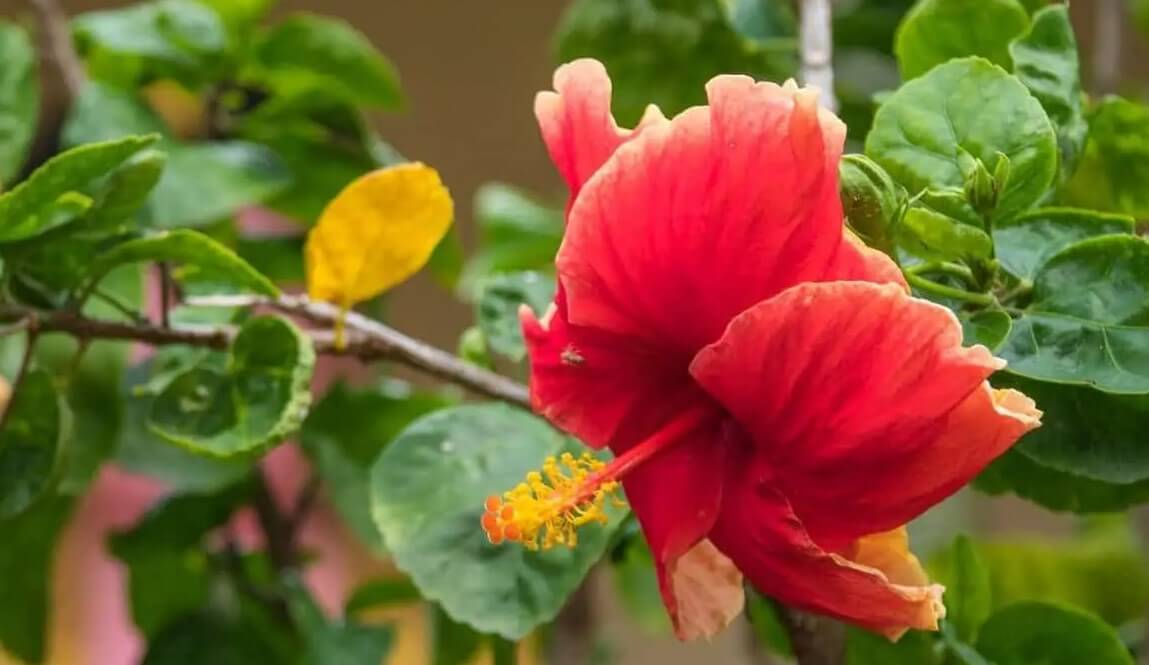
Hibiscus Leaves Turning Yellow: Improper Soil pH
One possible reason why your hibiscus leaves are turning yellow could be due to improper soil pH. Hibiscus plants prefer slightly acidic soil with a pH range of 6.0 to 6.8. If the soil is too alkaline or too acidic, it can affect the nutrient uptake by the plant, leading to yellowing leaves.
To fix this issue, you can test the pH level of your soil using a testing kit from your local gardening store and then make adjustments accordingly.
To correct alkaline soil, you can add organic matter such as peat moss or compost to increase acidity. On the other hand, if your soil is too acidic, you can add lime or wood ashes to raise the pH level.
It’s important to regularly monitor and amend the soil pH to maintain optimal conditions for your hibiscus to access all the vital nutrients it requires. Improper pH restricts nutrient availability and causes deficiency.
Solutions for Improper Soil pH
- Test soil pH annually with an at-home test kit.
- Hibiscus prefers a slightly acidic pH between 6.0-6.5.
- To lower pH in alkaline soil, add elemental sulfur or peat moss.
- To raise pH in acidic soil, add dolomitic lime or crushed eggshells.
- Re-test soil 4-6 weeks after adding amendments to see if pH shifted.
- When transplanting, choose an acidic soilless mix for hibiscus.
- Incorporate compost which provides nutrients without affecting pH.
- Use pots with drainage holes to prevent alkaline salts from accumulating.
- Consider a dilute vinegar solution for temporary acid boost (1 tablespoon per gallon water).
- Don’t let pH adjustments shift too quickly or severely in either direction.
Hibiscus Leaves Turning Yellow: Pest Infestation
Pest infestation can also be a cause of yellow hibiscus leaves. Common pests like aphids, spider mites, and whiteflies can suck the sap from the leaves, causing them to turn yellow.
These tiny critters may also leave behind sticky residue or white spots on the underside of the leaves. To tackle this issue, you can use organic insecticidal soap or neem oil to control these pests.
Regularly inspect your plant for any signs of pest presence and take immediate action to prevent further damage. Keeping your hibiscus healthy and pest-free is key to ensuring vibrant green leaves.
Solutions for Pest Issues
- Check undersides of leaves thoroughly for signs of pests.
- Remove affected leaves and isolate plant from others if infestation is severe.
- Wash leaves gently with a strong stream of water to dislodge pests.
- Apply neem oil or insecticidal soap according to label instructions.
- Introduce ladybugs or lacewings to naturally control aphids.
- Use sticky traps near plant to catch adult flying insects.
- Apply diatomaceous earth on and around pot to deter crawling insects.
- Maintain proper plant health and soil fertility to avoid attracting pests.
- Prune off heavily infested branches if they cannot be saved.
- Consider using a systemic insecticide for severe infestations that penetrate leaf tissues.
- Quarantine new plants away from existing collection to prevent pest spread.
Hibiscus Leaves Turning Yellow: Improper Pruning
You may also notice yellow hibiscus leaves after pruning. If not done properly, pruning can stress the plant, especially if you cut back too much at once or make the cuts incorrectly.
Pruning shock could be the cause of yellowing leaves if large branches were recently removed or remaining stubs are infected. Make sure to use clean, sharp pruners and only remove up to 1/3 of the foliage at a time to avoid overwhelming your hibiscus.
Solutions for Pruning Issues
- Disinfect pruning tools before each use to prevent disease spread.
- Prune branches just above an outward facing bud or leaf node.
- Use clean cuts rather than jagged snips which can become infected.
- Space out gradual pruning over time instead of dramatic shearing.
- Apply pruning paint or sealant to any cut larger than 1 inch in diameter.
- Avoid removing more than 30% of the foliage at any one time.
- Monitor for proper wound closure on cut branches.
- Increase nitrogen fertilization to help the plant recover after major pruning.
- Time pruning to avoid cutting during growth surges or right before winter dormancy.
- Remove crossing, damaged, or congested branches to improve air flow.
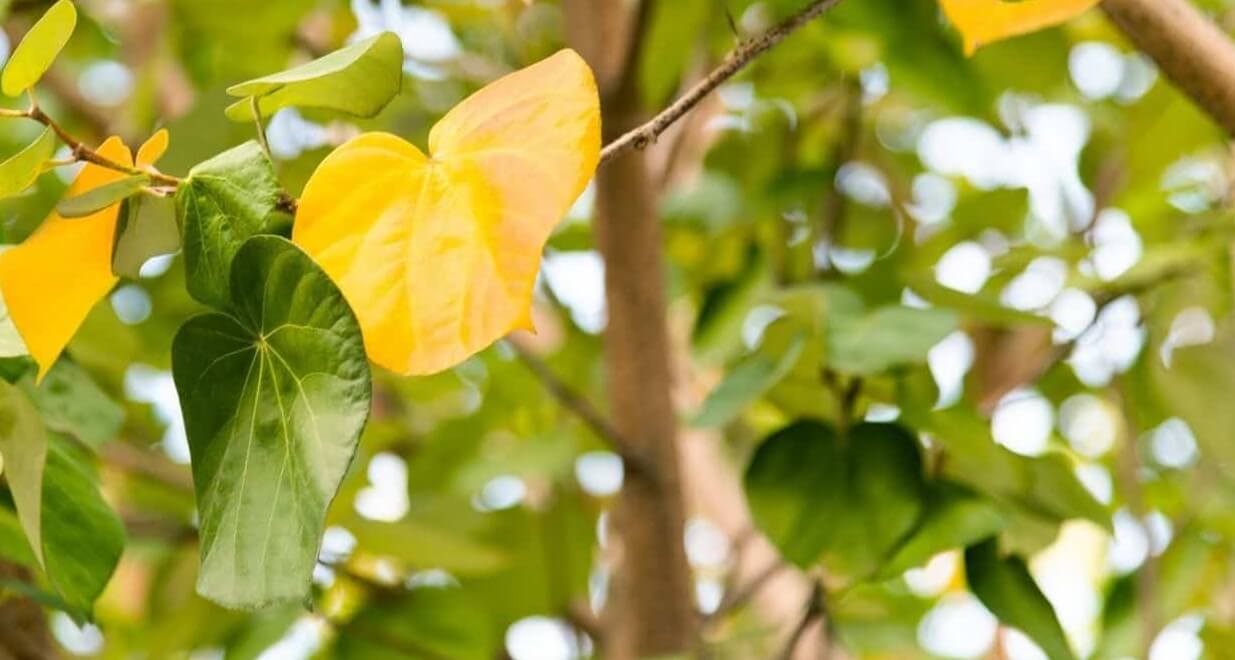
Hibiscus Leaves Turning Yellow: Drafts and Wind
Strong winds and drafts can also contribute to your hibiscus leaves turning yellow. The constant movement of the leaves caused by wind can lead to dehydration and damage, resulting in discoloration.
Additionally, cold drafts can shock the plant and cause stress, leading to yellowing leaves. To protect your hibiscus from wind and drafts, consider placing it in a sheltered location or using a wind barrier such as a fence or wall.
This will help create a more stable environment for your plant and prevent unnecessary leaf damage. Shielding your hibiscus from excessive air circulation will help maintain leaf health and color.
Solutions for Draft Issues
- Site hibiscus plants out of the path of prevailing winds.
- Build a windbreak using a trellis, lattice, tall plants, or garden fence.
- Avoid placing pots where AC vents or doors cause frequent cold drafts.
- Use a humidity tray with pebbles under your pot to increase local moisture.
- Mist leaves regularly to counteract drying winds.
- Move outdoor plants to a sheltered location if wind damage becomes a reoccurring issue.
- Consider using a portable windscreen during windy seasons.
- Improve durability against wind damage by providing optimal care in other areas.
- Rotate pot occasionally to ensure even wind exposure rather than one side constantly battered.
- Prune damaged leaves promptly to prevent issues spreading.
Hibiscus Leaves Turning Yellow: Dormancy Period
During periods of dormancy, hibiscus plants may experience yellowing leaves. This is a natural process where the plant conserves energy during colder months or when there is a lack of sunlight.
The reduced sunlight and cooler temperatures can cause the leaves to turn yellow and eventually fall off. While it may be alarming at first, it’s important to understand that this is a normal part of the plant’s growth cycle.
To support your hibiscus during dormancy, reduce watering and avoid fertilizing. Place the plant in a cool location with indirect light until signs of new growth appear in spring or when conditions become more favorable for growth again.
As long as the yellowing leaves are not accompanied by signs of disease or pest damage, it is generally nothing to worry about for overwintering plants. Your hibiscus will perk back up when its dormant period concludes.
Caring for Dormant Hibiscus
- Move dormant potted plants to an unheated garage or basement.
- Cut back on watering but don’t allow roots or soil to dry out completely.
- Discontinue fertilizer application until spring.
- Remove spent flowers but avoid major pruning.
- Inspect occasionally for pests while dormant.
- Keep light levels reduced but avoid complete darkness.
- Wait until risk of frost has passed before moving back outdoors.
- Resume normal care when new growth begins to emerge again in spring.
- Do not over-prune dieback on dormant plants; leave some yellowed foliage intact.
Hibiscus Leaves Turning Yellow: Environmental Shock
If you recently transplanted your hibiscus or made dramatic changes to its growing conditions, the stress and shock could cause yellowing leaves. Issues like replanting, repotting, or severely pruning roots often lead to hormones being imbalanced in the foliage.
Transplant shock may initially cause wilt, but in the following days and weeks, you are likely to see chlorosis spread in the leaves. Try to avoid shocking your hibiscus by changing multiple variables at once and give it proper post-transplant care to acclimate.
Helping Hibiscus Recover From Shock
- Water thoroughly after transplanting and monitor soil moisture closely afterwards.
- Stake or trellis tall plants to stabilize and support them if newly planted.
- Make adjustments gradually over several weeks when changing light levels or temperatures.
- Use a transplant or rooting fertilizer to reduce stress after repotting.
- Prune off only damaged leaves rather than removing large amounts of foliage.
- Maintain higher humidity around plant by misting daily after transplant shock.
- Keep the plant shaded for a few weeks while it establishes new root growth.
- If repotting in the same container, disturb roots as little as possible.
- Ensure proper soil aeration and drainage to prevent hypoxia after transplant.

Hibiscus Leaves Turning Yellow: Root Damage
Unhealthy, damaged, or restricted roots can also be a precursor to yellow hibiscus leaves. Root issues impact the plant’s ability to take up moisture and nutrients effectively. Causes of root problems include waterlogging, girdling roots, transplant stress, pests like root mealybugs, root rot diseases, and inadequate soil depth.
If the root system is not functioning optimally, the plant simply cannot facilitate adequate resources to all its foliage, resulting in the yellowing you see. Tackle root problems first if you suspect they are impeding your hibiscus’s health.
Addressing Root Damage
- Carefully inspect roots for visual signs of damage, rot, or pests.
- Remedy drainage and overwatering issues to prevent root hypoxia.
- Loosen circling or bound-up roots that may be strangling the plant.
- Apply beneficial mycorrhizae fungi to help heal damaged roots after repotting.
- Prune off badly damaged roots and repot in fresh, sterile potting mix if necessary.
Additional Causes of Hibiscus Leaves Turning Yellow
While improper cultural care is the most common reason for hibiscus leaf yellowing, other causes can sometimes be at play. Here are a few more issues that may lead to yellowing.
Viral or Bacterial Infections
Hibiscus plants are prone to certain diseases that affect leaf color and health. Bacterial leaf spot, fungal leaf spot, tomato spotted wilt virus, and hibiscus mosaic virus can all cause yellowing of the leaves, often mixed with spots, lesions, or distorted growth.
These pathogens spread easily between plants and require prompt removal of infected foliage as well as strict sanitary practices. Isolate and discard diseased plants to prevent spreading issues through your collection.
Age-Related Deterioration
As hibiscus plants mature, it is natural for older leaves to eventually yellow and drop off. This is not necessarily indicative of a cultural problem. Lower interior foliage is the most likely to show age-related yellowing while new growth remains healthy.
Prune off particularly unsightly old leaves but avoid over-pruning the plant. Fertilize regularly and provide ideal care to encourage fresh new foliage.
Natural Senescence
Towards the end of the growing season as daylight decreases, hibiscus plants will begin shutting down metabolic processes and outputting less chlorophyll. This natural senescence leads to yellowing leaves in fall even if care is perfect.
Do not be alarmed by some yellowing on a seasonal hibiscus as it enters dormancy. Avoid excess fertilizer at this time and let the plant take its natural course entering into rest. The cycle will reset in spring.
Chemical Leaf Scorch
Using certain pesticides, strong fertilizers, or tap water with high mineral content can sometimes result in leaf scorch. This appears as browning, yellowing, or curling leaf margins and tips resulting from chemical damage.
Rinse leaves after applying any treatments and leach soil periodically to prevent hazardous chemical buildup. Switch to distilled, rain, or filtered water if hard tap water seems problematic.
Solutions and Prevention for hibiscus leaves turning yellow
Now that we’ve explored the multitude of potential reasons behind your hibiscus leaves turning yellow, let’s discuss solutions and prevention strategies.
Pruning Affected Leaves
As you work to diagnose and address the underlying issue, you can prune off badly affected yellow leaves to improve appearance and encourage new growth. This removes the visible damage.
Use clean, sterilized pruners to prevent spreading any infections. Make cuts just above an outward facing bud or node. Remove no more than 1/3 of foliage at a time to avoid stressing the plant further.
Proper Site Selection
Choose an ideal location from the start to avoid issues like insufficient sunlight, drafts, cold damage, and excess wind. Pick a sheltered spot with maximum sunlight exposure that allows for proper winter protection.
Position hibiscus thoughtfully for optimal cultural care rather than just filling an empty corner. This gives your plant the conditions it inherently requires.
Monitor Soil Moisture
One of the easiest ways to prevent yellow leaves is checking soil moisture frequently. This allows you to properly hydrate on schedule before underwatering, or withhold water before saturation triggers root issues.
Use your finger to probe the top few inches of soil and water when just the surface is dry. Moisture monitoring removes the guesswork.
Fertilize Regularly
Prevent nutrient deficiencies leading to chlorosis by applying a balanced fertilizer every 2-4 weeks during the growing season. Use a formula made for flowering plants and follow label instructions carefully.
In fall and winter, reduce fertilizer to once a month or stop until spring. Regular feeding keeps nutrients available.
Inspect for Pests
Check leaves, stems, buds, and even the soil regularly for any signs of insect pests. Address infestations immediately before they escalate and spread. Identify pests quickly by the damage they cause.
Remove or isolate affected plants promptly to avoid cross contamination. Don’t let pests sap your hibiscus’s health.
Control Environmental Factors
While some variables are beyond our control, do your best to modify the microclimate around your hibiscus. This may mean moving pots around to adjust sun exposure, using wind blocks, monitoring indoor temperatures, or filtering hard water.
Stabilize any elements you can influence to optimize the care environment and prevent stress reactions.
When to Seek Expert Help for Hibiscus Leaves Turning Yellow
If you diligently apply these troubleshooting tips but your hibiscus leaves remain yellow, it may be time to seek professional advice. Diagnosing unknown diseases can be challenging. Seek lab testing at your local agricultural extension office.
Consult with a horticultural specialist if you need help identifying a recurring pest issue or have already treated for common problems without success. Sometimes underlying factors are not visible.
Reaching out to experts can provide fresh insight when you have hit a wall in reviving your yellowed hibiscus back to health. Don’t hesitate to ask for help when needed!
Conclusion hibiscus leaves turning yellow
I hope identifying all the potential reasons behind yellow hibiscus leaves empowers you to get to the root of the problem in your garden. Whether it is overwatering, light deficiency, pests, or any number of other issues covered, use this guide to systematically rule out causes.
Catching and correcting problems early is key before lasting damage sets in. With quick observation skills and these troubleshooting tips, you can nurture your hibiscus plants back to their maximum vibrant beauty. That gorgeous green foliage will return if you take the right steps!
